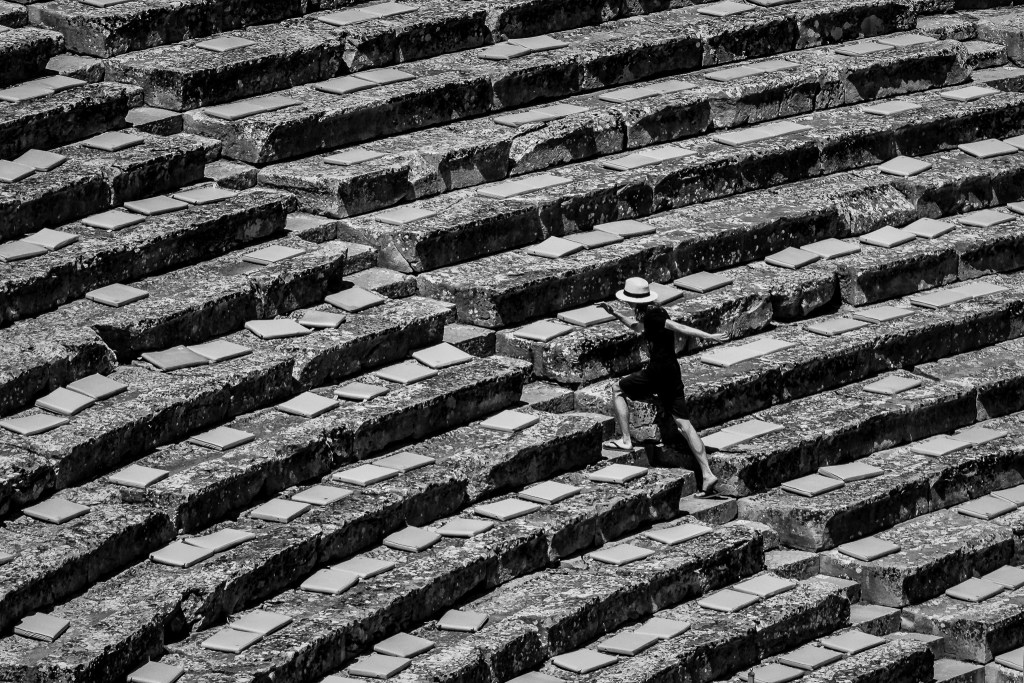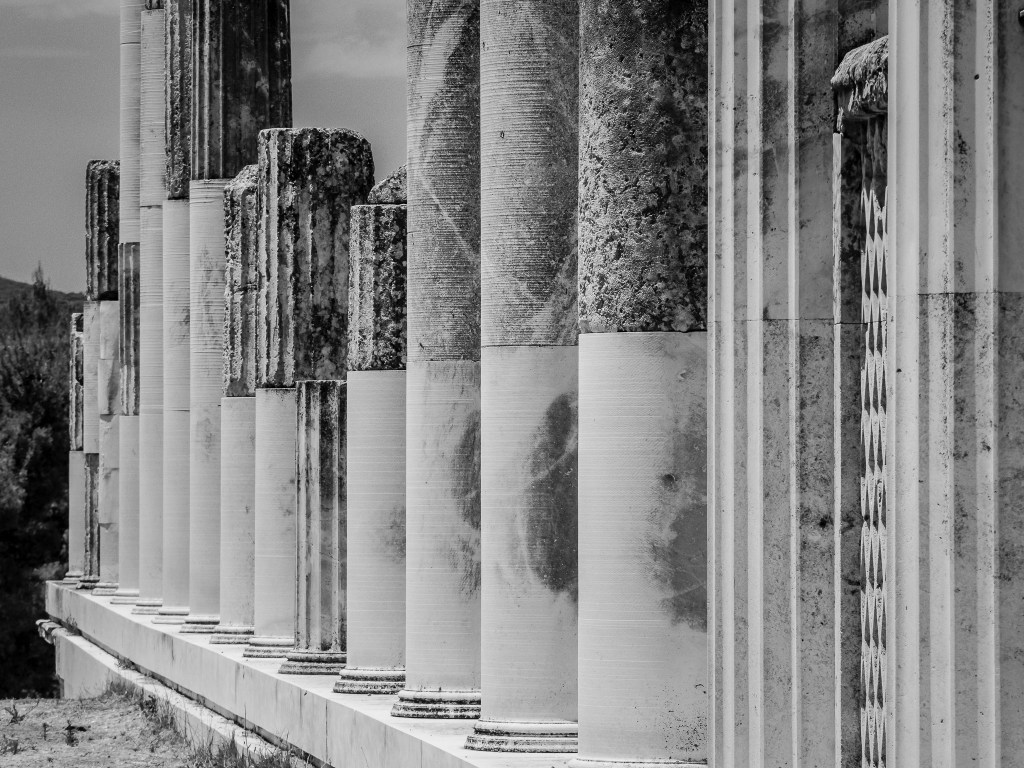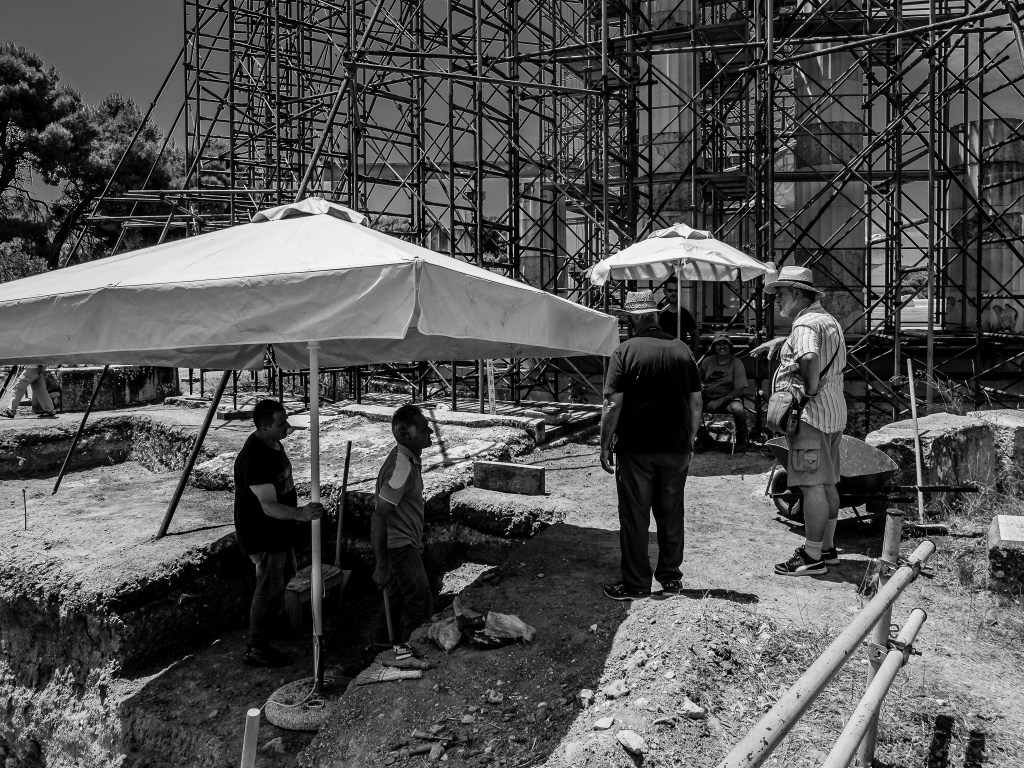
One of the first sightseeing trips in Greece had The Significant Other and I heading to Epidaurus, one of the prime Hellenic tourist destinations. Primarily known for its ancient theatre, Epidaurus is the most important ancient place of worship for the god of healing Asklepios. For more of its history and a few images click below…

Epidaurus is situated on the Argolis peninsula at the Saronic Gulf. It is said to be the birthplace of Apollo’s son Asklepios the healer. The Asclepion at Epidaurus was the most celebrated healing center of the classical world, the place where ill people went in the hope of being cured. To find out the right cure for their ailments, they spent a night in the enkoimeteria, a big sleeping hall. In their dreams, the god himself would advise them what they had to do to regain their health. Within the sanctuary there was a guest house with 160 guest rooms. There are also mineral springs in the vicinity, which may have been used in healing.
The many visitors seeking cure to their ailments brought prosperity to the sanctuary, which in the 4th and 3rd centuries BC embarked on an ambitious building program for enlarging and reconstruction of monumental buildings. Fame and prosperity continued throughout the Hellenistic period. In 87 BC, the sanctuary was looted by the Roman general Sulla. In the 2nd century AD the sanctuary enjoyed a new upsurge under the Romans, but in AD 395 the Goths raided and destroyed the sanctuary. Even after the introduction of Christianity and the silencing of the oracles, the sanctuary at Epidaurus was still known as late as the mid 5th century as a Christian healing center.

The primary attraction is the theatre, considered one of the best preserved theatres of antiquity. It was built in the 4th century BC (~ 330 BC) overlooking the mountainous landscape of Argolis. The 55 rows seat 15.000 people. The round orchestra is bordered by a circle of marble, the floor consists of stamped clay. Behind it was a large stage house (skene), of which only the foundations remain today. The skene once served as a dressing room, for the storage of theater props and – after a change in performance practice at the beginning of the 3rd century BC – also as a place for the performers to perform and play. The stage wall was hung with panels that served as a backdrop for the respective play.
The theatre has excellent acoustics, so that every word can be understood even from the top rows. In the center of the stage there is a cylindrical stone slab in the floor, visitors to the excavation site can test the acoustics by dropping a coin on this slab, for example. The coin can be heard even in the last tiers. Another test is the tearing of a sheet of paper. When we were there, some visitors very capable of singing performed pieces from the musical Oklahoma, which was quite impressive to hear while we sat in the top row, observing the scene below.
Since 1955 the theatre is the venue of the Festival of Epidauros.




The ancient guesthouse (Katagogion) can be recognized today only in its foundation walls. It was once a large, two-story building that provided rooms for about 160 pilgrims and those seeking healing. The sheer size of this building, which dates back to the 4th century BC, testifies to the importance of Epidaurus.

In a natural depression is the stadium of Epidaurus, dating from the 5th century BC, which is overall much better preserved than the historically more important stadium of Olympia. The running surface is 21.5 meters wide and 181.3 meters long. The starting system and the ancient rows of seats located on the long sides are still partially present – on one side they are as they were excavated, on the opposite side they are arranged according to ancient models. The seats have been partly hewn out of the rock, partly bricked. The seats of honor – seats with backs – were located on the southern long side. The stadium is connected by an underground passage with the Palestra and the Gymnasion, the places where the athletes stayed to prepare for the competition. For demonstration purposes, competitions are still held in the stadium today.

The Propylaea represent the actual entrance to ancient Epidaurus. The visitor first passed through the two porticoes, each with six columns, before entering the sacred street towards the Holy District. These entrance halls were probably built between 340 and 320 BC.


The Abaton is a rectangular building (21 m × 24 m) whose beginnings date back to the 6th century BC. Thus, it is the oldest building of the sacred district. At the time of the worship of Asklepios, it probably served as a dormitory for the patients. The sick lay down for healing sleep (temple sleep) and waited for the god to heal them.


We also saw some archeologists at work. The boss has some resemblances to Indiana Jones, doesn’t he? Or his he more the professor from Jurassic Park? It’s yours to decide. They were working below the Tholos, a round temple, built by Polykleites between 365 und 335 BC.


We closed out our visit to Epidaurus in the museum of the sanctuary, where statuettes, the small cult figures made of ceramics and marble, are displayed, as well as some statues of the worshipped gods, a model of the Tholos and other objects found during the excavations.
The photographs were taken with the Olympus OM-D E-M1X with the mZuiko 12-100 F/4, the Leica M with the Summicron 50mm F/2 and the iPhone 12 Pro Max. Can you identify which image was taken with which cam?
The Leica monochrome images are jps straight out of cam, the other were concerted in Lightroom Classic. Why I post this series black & white? Well, first I love black and white. And in harsh lighting conditions (as during a sunny greek midday) you don’t need to worry about washed out, flat colors. Focus on contrast, textures and shapes, and you will still come up with great images, despite “bad” light. Especially when traveling, you can’t always be on location during the golden hour, so you have to adapt your shooting to the conditions you find. We were on a day trip, combining Epidaurus with a trip to the volcanic Methana peninsula, so Epidaurus had to fall into the high noon shooting conditions.
I hope you liked the first of my “Greece Explored” posts. Stay tuned for more.
Have a great Tuesday
Marcus
Related Posts:
Amazing
Thanks, much appreciated! Marcus
Wlcm
Please follow me
How insanely old are these structures 😲 … and still it’s a beautiful sight. Well, if we can’t go to Greece in person, we’ll travel virtually on your blog!
Thanks for taking the time to read and comment, so much appreciated! Glad to have you along for the journey 😉
Marcus
This is a terrific post, Marcus.The information and beautiful black and white photos make me want to visit Greece. It’s a great tour of the site. Your reason for choosing black and white is a valuable lesson. But I cannot tell which photos were made with which camera!
Thanks, Lynn, appreciate your kind words, glad you liked the post. As Allan commented about the different cameras – who cares in the end 😉 ?
Marcus
Although we didn’t charm anyone with our singing of songs from Oklahoma, we did try out the acoustics with “speeches.” Great photos and a good reason to use black and white. I hadn’t thought of that. Thanks for the info, great pictures, and interesting composition. You make me want to go back!
Thanks so much for your feedback. Great you git see the this splendid place yourself. Glad I brought back some memories! Marcus
Thanks for sharing Marcus. Very fine pictures evoking nostalgic memories of this remarkable place
Thanks, Jim, so much appreciated! Marcus
Wow! Exceptional post, images, and lesson in history. Thanks for sharing!
Thanks so much, Alina, glad you liked the post! Marcus
wonderful shots. I can’t tell which camera, but who cares?
Thanks, Allan, and you are right, of course, about the cams. It’s the output that counts! Marcus
These are very beautiful photos, Marcus! I would love to see that huge stadium in person. So much incredible history, these folks didn’t do anything half-way did they. Thank you for this tour!
Thanks, John, so glad you liked the post! It is an impressive site indeed. Marcus
Thanks for these exceptional captures and you explaining about these places.
Thanks so much, I’m glad you liked the post! Marcus